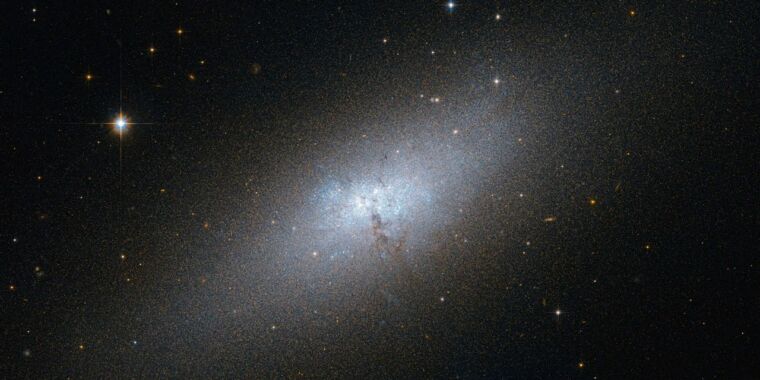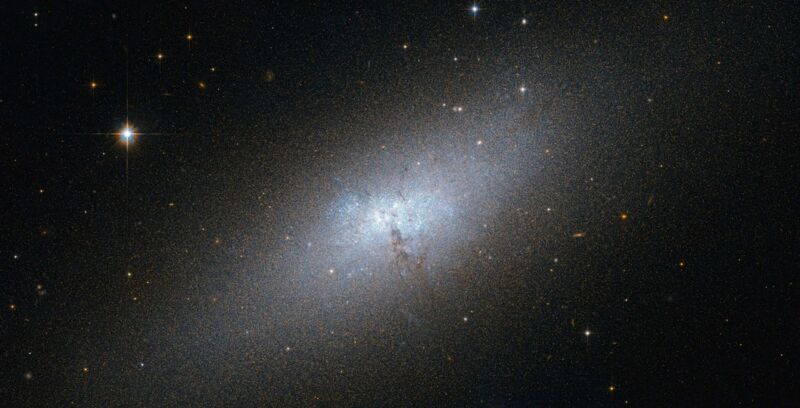

Impossible for a telescope to image and far from being fully understood, dark matter is nonetheless everywhere.
The deepest mysteries of dark matter relate to its nature and behavior. The prevailing idea regarding dark matter is the cold dark matter (CDM) theory, which posits that dark matter consists of low-velocity particles that do not interact with each other. This thinking has been discussed, and is up for debate again. Led by astrophysicist Hai Bo Yu, a team of researchers from the University of California Riverside has come up with an alternative idea that explains the extremes where cold dark matter doesn’t work so well.
Galaxies and galaxy clusters are thought to be surrounded by halos of dark matter. On one end of the debate are galactic dark matter halos that are too dense to be compatible with the CDM, and on the other end are galactic dark matter halos that are too diffuse for the CDM to understand. Yu and his colleagues instead suggest that some dark force (sorry Star Wars fans – no the force) causes dark matter particles to collide with each other. This is self-interacting dark matter, or SIDM.
The idea of invisible particles interacting, either pushing each other away and outward in a diffuse corona, or closer together and inward in a dense corona, may be what we’ve been searching for in the dark. But first, why is dark matter overwhelmingly thought to be cold?
Lost in the dark
Dark matter is “dark” because its interactions with visible matter and electromagnetic radiation are either weak or non-existent. No light can illuminate it because it is unable to make significant interactions with any type of electromagnetic radiation. The reason dark matter is described as “cold,” at least according to cold dark matter theory, is that slow particles are thought to move much slower than the speed of light.
The CDM remains the standard model for dark matter because it serves to build and maintain cosmic structures such as galaxies. If dark matter were cold, it could collect and aggregate more easily than if it were traveling through the vacuum of space, which would be the case if all dark matter were “hot” or made up of lighter particles moving at high speeds. Hot dark matter particles would be too fast to form structures over long periods of time, and might flatten any existing structures they collide with. Warm dark matter falls somewhere between cold and hot.
How many types of dark matter actually exist is unknown. Some scientists insist that all dark matter is cold, while others argue that there is more than one type.
Although the CDM does not say that this invisible matter is completely motionless, it does not allow for many dark matter particles to collide. This is where SIDM comes in.
Shed more light
While hot and warm dark matter were outside the scope of their study, Yu and his team tested whether SIDM could explain one aspect of cold dark matter that doesn’t really work: it struggles to explain very dense, very diffuse dark matter halos.
“In the [diffuse scenario]Interactions transfer heat from outer to inner corona regions, reducing the central density; In the [dense scenario]“The direction of the heat flow reverses and the inner corona becomes denser than its CDM counterpart,” they said in a statement. Stady It was recently published in The Astrophysical Journal Letters.
Ultra-diffusive galaxies UDGs are particularly dim dwarf galaxies because their stars are scattered far apart from each other. The star-forming gas is spread out too thinly to produce many new stars. The dark matter halo of an ultra-diffuse galaxy reaches much farther away than that of a regular dwarf galaxy, which should not happen with the non-colliding particles proposed by the CDM – particles that do not interact would be closer together and produce a denser halo with Shorter range. SIDM allows particles to collide and transfer heat, and the resulting dark matter expansion could explain why these halos are so common.
The second scenario deals with dark matter halos that are so dense that they have an effect on gravitational lensing. These dense haloes contain enough dark matter to bend spacetime so that light traveling through that region of space is also bent. Because of these disturbances, the object behind the lenticular galaxy is magnified, although often in a somewhat distorted manner. SIDM also supports dark matter concentrations sufficient to affect gravitational lensing, because colliding particles should be able to point inward just as well as outward. Particles colliding with each other increases the density of the corona, and a swarm of them can form a huge bubble of dark matter that produces gravitational lensing.
We’re still in the dark about dark matter in many ways. Until there is a way to detect them directly, we will have to rely on theoretical work to see whether ideas like SIDM can be of any use. Perhaps one day, we will have a direct detection method that will finally shed light on the secrets of dark matter.
Astrophysical Journal Letters2023. Digital ID: 10.3847/2041-8213/ad0e09

“Web maven. Infuriatingly humble beer geek. Bacon fanatic. Typical creator. Music expert.”





More Stories
Scientists confirm that monkeys do not have time to write Shakespeare: ScienceAlert
SpaceX launches 23 Starlink satellites from Florida (video and photos)
A new 3D map reveals strange, glowing filaments surrounding the supernova